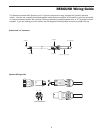
Connecting the Resound Speaker System
5
Choosing the Correct cables
The Resound series speakers connections are made via the rear panel 1/4-inch and/or Neutrik Speakon® con-
nectors. Standard unshielded speaker wire, available at your local pro audio or music store, with either 1/4-inch
phone or Speakon connectors and wire gauge of 12-14 is recommended.
If your amplifier uses binding posts you can use speaker cables with banana plugs, but be sure to pay attention to
the plus and minus polarity when making the connections. It is important that your PA system is connected in
phase otherwise you will not have the proper low-end response and stereo image.
In order to ensure that your PA system is in phase, be careful to pay close attention to the positive and negative
marking on the amplifier and wires. Make sure that the + terminal of the speaker, or banana connector, is con-
nected to the + terminal of the power amplifier and that the - terminal of the speaker, or banana connector, is con-
nected to the - terminal of the power amplifier.For a detailed wiring diagram, see page 9 of this manual.
Here’s a tip:
It’s fairly easy to identify a monitor that is out of phase just by listening, especially on a pop record.
Listen for the parts of the music that you would expect to be in the center of the mix like kick drum and vocals. If
you do not hear them directly in the center (for instance they sound like they are two signals panned hard right
and left) then you are more than likely listening to an out-of-phase monitor system. (This test won’t work on early
Beatles records where Ringo’s drum kit is panned all the to the right side. Try a Madonna record.)
About Impedance
Before you hook up your speaker cabinet, be sure that you understand a little about impedance. Impedance is
the electronic load that the speaker puts on the power amplifier and is measured in Ohms.
Here is the tricky, yet simple rule of impedance: When two speakers, of equal impedance are wired in "Parallel",
like when you use the Extension Output, the total impedance is cut in half and when two speakers are wire in
“Series”, (usually for interna cabinet wiring only), the total impedance is the sum of the speakers individual imped-
ance.
Each of the Resound models, EXCEPT the RS215 is 8 Ohms. So, when two Resound models, EXCEPT the
RS215 are connected together in parallel, the total impedance is 4 Ohms. The RS215 impedance is 4 Ohms. So,
when two RS215’s are connected together in parallel, the total impedance is 2 Ohms. The impedance of your
speaker also has an effect on your amplifier. In general, the lower the impedance, the more power your amplifier
will put out.
IMPORTANT NOTE
: There is minimum safe impedance for running power amplifiers so be sure to check the man-
ufacturer’s recommended impedance for your amplifier to avoid any damage to your amplifier or voiding your
warranty.
Using the EXTENSION Output
The Resound models provide a convenient Extension Output for connecting additional speaker cabinets in paral-
lel. Be sure to read the section above on impedance to insure a proper hook up with your amplifier. To connect
two Resounds using the Extension output, connect your amplifier output to the Input of the first Resound and
then, connect the Extension Output to the Input of the second Resound.
Powering the Resound
Each of the Resound loudspeakers have a specific power rating, which is printed on the input jack-plate, and
also, in the Specification section on page 10 of this manual. Be sure to check that your power amp has the cor-
rect power output for your Resound. Be careful to consider the total impedance if you are connecting more the
one Resound to one side of a stereo power amplifier. Using a power amplifier with too low of a power rating can
be dangerous since the output signal is often clipped in an effort to get the desired level. Over powering the
Resound can result in catastrophic failure and therefore using any amplifier with a power rating over the recom-
mend power rating may void your warranty.


















